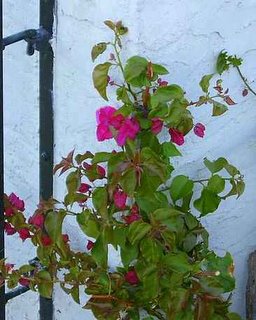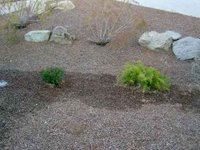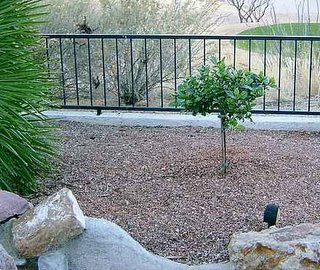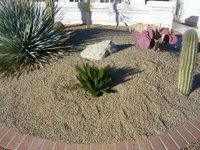It all started because I noticed a number of drip endings that had no plants to water, usually because the plant had died and been removed. And I thought we might as well use them by planting new plants. I also noticed that several plants were in poor condition or being overgrown by larger plants. So Steve and I headed down to the Home Depot and Target garden centers. These centers had recently filled up with all kinds of non-Minnesota interesting plants as the spring season has come to Tucson. We sought plants that could be of interest in the winter here, since that is when we will be here.
Corroded ends
I had noted that of the three drip ends that were to water the new tree, only one was dripping water. Apparently they just hooked them up without testing them. In addition, the older drip endings had never been touched since installed years ago and many were closing down from corrosion. That seemed to correlate with some plants appearing to suffer while others that still had good openings from their drips were doing well. I also noticed that there was an area where water was draining to from excess water at one large palm frond plant. So we found product at Home Depot to fix these lines and endings. I opened up corroded ends where I could and replaced unfixable ends (especially where we did new plantings) with a new style of seepage tubes. And I added extensions to reach new areas of plantings where we had to move them away from larger plants. In the future we should do testings of these drips on a regular basis. I think Norwegian gardeners are more diligent about these things.
 The total cost of plants, about $100. Tools and supplies (including new floaters in the pond), about $40. Seeing your brothers doing manual labor, priceless.
The total cost of plants, about $100. Tools and supplies (including new floaters in the pond), about $40. Seeing your brothers doing manual labor, priceless.The bouganvillea are coming back. We looked at the long range forecast and saw no temps below 40 degrees so we went after them with clippers. Cut them well back as they are vigorous growers. Already showing nice new blooms. Next year we will have to try to cover them on freezing nights to avoid the unsightliness that they had this winter. Are there any of those old bedroom muslin drapes/sheets left that we could use?
 The flower on left is simply new rabbit food, the one on the right we moved to make way for a newer, better plant. It may not do well with its roots in water all the time, but we figured it wasn't doing well where it had been so what the heck. No need to extend the drip system here. This was the hardest digging as there were lots of rocks underneath.
The flower on left is simply new rabbit food, the one on the right we moved to make way for a newer, better plant. It may not do well with its roots in water all the time, but we figured it wasn't doing well where it had been so what the heck. No need to extend the drip system here. This was the hardest digging as there were lots of rocks underneath.We also moved a similar plant that was being overshadowed by the palm frond plant on the south side. We moved that one to replace a smaller one of the same species that was doing poorly. We increased the drip flowage to it so maybe this one will do better. We will find out if it is the water or if it prefers more shade than it was getting.
 At right is the new Tucson Blue Rosemary plant. It is similar to the Rosemary already there that is healthy but has no flowers on it. The new one is supposed to have blue flowers year around. Steve fertilized one that he guarantees will bloom forever.
At right is the new Tucson Blue Rosemary plant. It is similar to the Rosemary already there that is healthy but has no flowers on it. The new one is supposed to have blue flowers year around. Steve fertilized one that he guarantees will bloom forever. This is the gardenia plant that is advertised as "everblooming." Please note that it is not presently blooming. Given its height, it would appear to be rabbit-proof. This is planted to the left of the rock path. Its white flowers should be a nice offset to the bouganvillea growing behind it.
This is the gardenia plant that is advertised as "everblooming." Please note that it is not presently blooming. Given its height, it would appear to be rabbit-proof. This is planted to the left of the rock path. Its white flowers should be a nice offset to the bouganvillea growing behind it. Stephen's romantic "Pink Breath of Heaven" are a nice contrast to the large pink flowers behind it. There was this little inset in the front patio that had housed something else at one time. Possibly a nice rabbit food plant like this one. Hope it survives. It softens things up a bit.
Stephen's romantic "Pink Breath of Heaven" are a nice contrast to the large pink flowers behind it. There was this little inset in the front patio that had housed something else at one time. Possibly a nice rabbit food plant like this one. Hope it survives. It softens things up a bit. Ta Da! I finally get a palm! This is a sago palm that replaces the spoon plant that died this summer. The dripper on the spot was barely functioning and may have had something to do with the spoon's demise. Anyway, this plant should grow to a significant size in time, perhaps 10 feet. However, we are unlikely to see such size as property owners. But our hope is that in a couple of years at least this one will be a nice specimen. The deep green gives Minnesota boys a warm feeling, in contrast to the cooler, starker shades of cacti.
Ta Da! I finally get a palm! This is a sago palm that replaces the spoon plant that died this summer. The dripper on the spot was barely functioning and may have had something to do with the spoon's demise. Anyway, this plant should grow to a significant size in time, perhaps 10 feet. However, we are unlikely to see such size as property owners. But our hope is that in a couple of years at least this one will be a nice specimen. The deep green gives Minnesota boys a warm feeling, in contrast to the cooler, starker shades of cacti.The leaves look soft but are sharply-pointed and that is a sign of a good chance of survival.